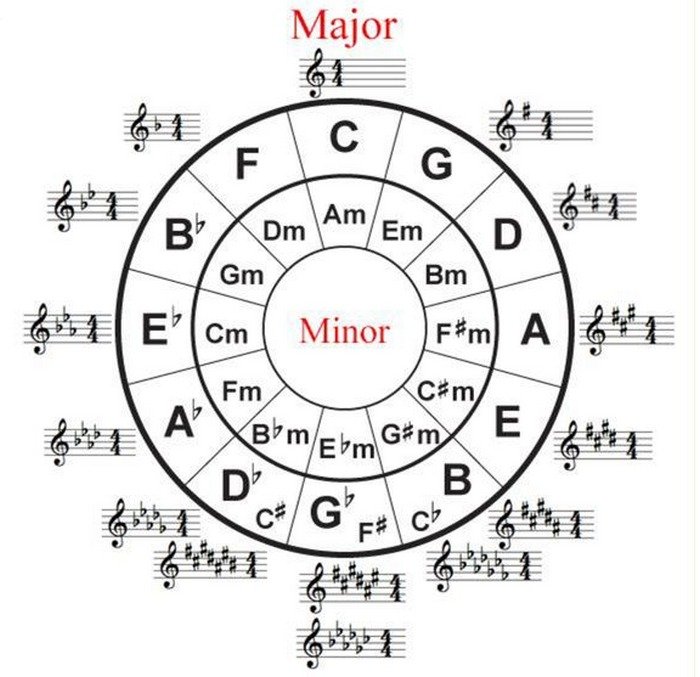The circle of fifths is a super useful tool for piano players that helps you understand the relationships between different keys and chords.
It’s basically a diagram that shows how all the major and minor keys relate to each other or how keys are connected by perfect fifths.
It’s a circular diagram that organizes the 12 different keys (major and minor) and the name comes from the key relationships it displays.
If you move clockwise around the circle, each new key is a perfect fifth higher than the previous one. Move counter-clockwise, and each new key is a perfect fifth lower.
Why is it called the Circle of Fifths?
The term “Circle of Fifths” refers to two key aspects of the concept:
– the circular arrangement of keys and
– the interval of a perfect fifth between adjacent keys on the circle.
Circle
The “circle” part of the name comes from the circular arrangement of keys on the diagram.

As shown in the above image, the keys are arranged in a circle, with each key positioned clockwise or counterclockwise next to its related keys.
This circular layout allows for a visually intuitive representation of the relationships between keys.
Fifths
The “fifths” part of the name refers to the interval of a perfect fifth between adjacent keys on the circle.
Starting from any key, if you move clockwise or counterclockwise to the next key, you are moving up or down by a perfect fifth interval.
For example, if you start on C and move clockwise to G, you’ve moved up by a perfect fifth.
Similarly, if you start on C and move counterclockwise to F, you’ve moved down by a perfect fifth.
This interval of a perfect fifth is a fundamental building block of Western music harmony, and it plays a central role in the relationships between keys, chords, and scales.
So, the “Circle of Fifths” is named for its circular arrangement of keys and the interval of a perfect fifth between adjacent keys, which are both fundamental aspects of the concept.
Sharps and Flats
The right side of the circle shows keys with sharps, and as you move clockwise, sharps are added one by one.
The left side of the circle shows keys with flats, and they also increase as you move counter-clockwise.
As shown in the below image, moving clockwise adds sharps, while moving counter-clockwise adds flats. (e.g., G major has one sharp, D major has two sharps, F major has one flat, etc.)

Why Circle of Fifths is Important for Piano Players?
Learning Scales & Chords
The circle helps you see how scales relate to each other. Keys next to each other on the circle share many notes, making them easier to learn.
Creating Chord Progressions:
The circle shows which chords work well together in different keys. This is fundamental for composing and playing songs.
Understanding Key Signatures
The circle of fifths makes it super easy to figure out any key signature.
For instance, the key of G major is located on the circle with one sharp. That sharp is F#.
- C Major (center): No sharps or flats.
- Clockwise (Sharps): G major (1 sharp), D major (2 sharps), A major (3 sharps), E major (4 sharps), etc.
- Counter-clockwise (Flats): F major (1 flat), Bb major (2 flats), Eb major (3 flats), Ab major (4 flats), etc.
Building Chords
Each key on the circle has common chords that belong to it.
The circle of fifths shows the relationships between these chords, helping you identify which chords will sound good together.
Songwriting and Improvisation
It’s a roadmap for smooth chord progressions. You can pick chords from nearby sections of the circle to create pleasing transitions in your music.
Transposing Music
The circle of fifths lets you easily transpose (change the key) of a piece of music.
If you know a song in the key of C, you can use the circle to figure out the notes and chords in any other key.
How to Use Circle of Fifths?
As a beginner, focus on these aspects of the circle of fifths:
- Memorize the order of keys: Start at C (no sharps or flats) and move around the circle both clockwise (sharps added) and counter-clockwise (flats added).
- Learn key signatures: Understand how many sharps or flats belong to each key.
- Explore basic chord progressions: Start with a key and play chords that are near it on the circle.
Summary
Overall, the circle of fifths is a foundational concept in piano playing that helps musicians develop their understanding of harmony, key relationships, and musical structure.
It provides a framework for exploring and creating music in a systematic and organized way.
The circle of fifths might seem complex at first, but with practice, it becomes a powerful tool for navigating the world of piano keys and music theory.


